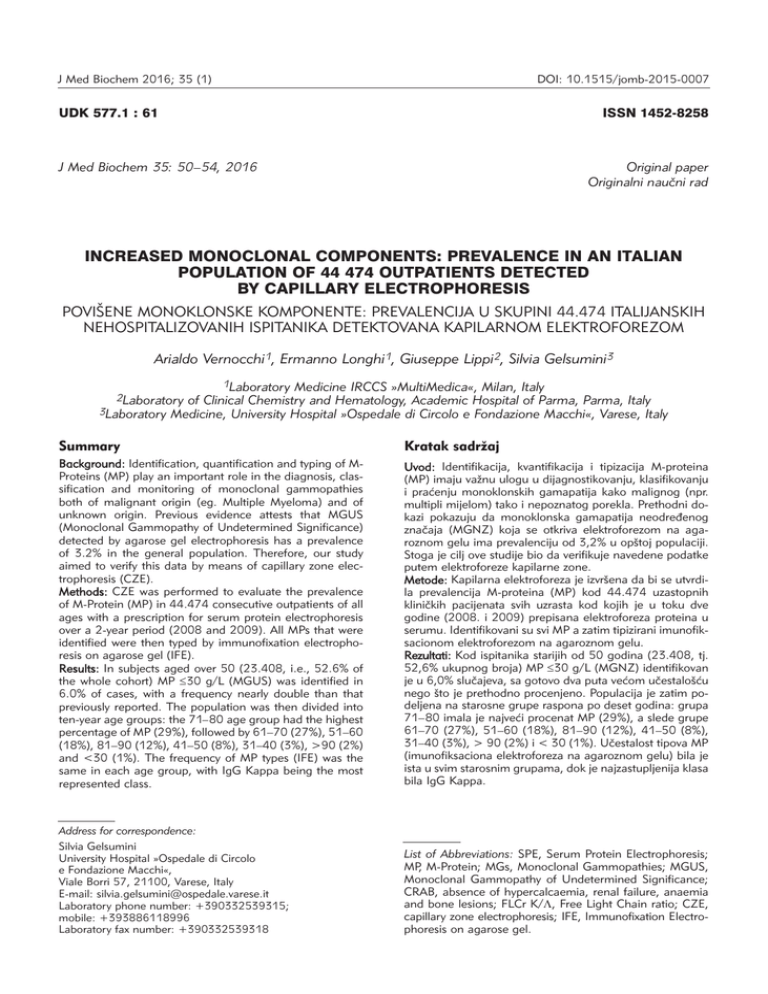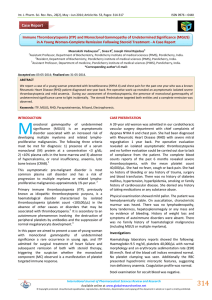increased monoclonal components: prevalence in an italian
advertisement

J Med Biochem 2016; 35 (1)
DOI: 10.1515/jomb-2015-0007
UDK 577.1 : 61
ISSN 1452-8258
J Med Biochem 35: 50 –54, 2016
Original paper
Originalni nau~ni rad
INCREASED MONOCLONAL COMPONENTS: PREVALENCE IN AN ITALIAN
POPULATION OF 44 474 OUTPATIENTS DETECTED
BY CAPILLARY ELECTROPHORESIS
POVI[ENE MONOKLONSKE KOMPONENTE: PREVALENCIJA U SKUPINI 44.474 ITALIJANSKIH
NEHOSPITALIZOVANIH ISPITANIKA DETEKTOVANA KAPILARNOM ELEKTROFOREZOM
Arialdo Vernocchi1, Ermanno Longhi1, Giuseppe Lippi2, Silvia Gelsumini3
1Laboratory Medicine IRCCS »MultiMedica«, Milan, Italy
of Clinical Chemistry and Hematology, Academic Hospital of Parma, Parma, Italy
3Laboratory Medicine, University Hospital »Ospedale di Circolo e Fondazione Macchi«, Varese, Italy
2Laboratory
Summary
Kratak sadr`aj
Background: Identification, quantification and typing of MProteins (MP) play an important role in the diagnosis, classification and monitoring of monoclonal gammopathies
both of malignant origin (eg. Multiple Myeloma) and of
unknown origin. Previous evidence attests that MGUS
(Monoclonal Gammopathy of Undetermined Significance)
detected by agarose gel electrophoresis has a prevalence
of 3.2% in the general population. Therefore, our study
aimed to verify this data by means of capillary zone electrophoresis (CZE).
Methods: CZE was performed to evaluate the prevalence
of M-Protein (MP) in 44.474 consecutive outpatients of all
ages with a prescription for serum protein electrophoresis
over a 2-year period (2008 and 2009). All MPs that were
identified were then typed by immunofixation electrophoresis on agarose gel (IFE).
Results: In subjects aged over 50 (23.408, i.e., 52.6% of
the whole cohort) MP ≤30 g/L (MGUS) was identified in
6.0% of cases, with a frequency nearly double than that
previously reported. The population was then divided into
ten-year age groups: the 71–80 age group had the highest
percentage of MP (29%), followed by 61–70 (27%), 51–60
(18%), 81–90 (12%), 41–50 (8%), 31–40 (3%), >90 (2%)
and <30 (1%). The frequency of MP types (IFE) was the
same in each age group, with IgG Kappa being the most
represented class.
Uvod: Identifikacija, kvantifikacija i tipizacija M-proteina
(MP) imaju va`nu ulogu u dijagnostikovanju, klasifikovanju
i pra}enju monoklonskih gamapatija kako malignog (npr.
multipli mijelom) tako i nepoznatog porekla. Prethodni dokazi pokazuju da monoklonska gamapatija neodre|enog
zna~aja (MGNZ) koja se otkriva elektroforezom na agaroznom gelu ima prevalenciju od 3,2% u op{toj populaciji.
Stoga je cilj ove studije bio da verifikuje navedene podatke
putem elektroforeze kapilarne zone.
Metode: Kapilarna elektroforeza je izvr{ena da bi se utvrdila prevalencija M-proteina (MP) kod 44.474 uzastopnih
klini~kih pacijenata svih uzrasta kod kojih je u toku dve
godine (2008. i 2009) prepisana elektroforeza proteina u
serumu. Identifikovani su svi MP a zatim tipizirani imunofiksacionom elektroforezom na agaroznom gelu.
Rezultati: Kod ispitanika starijih od 50 godina (23.408, tj.
52,6% ukupnog broja) MP ≤30 g/L (MGNZ) identifikovan
je u 6,0% slu~ajeva, sa gotovo dva puta ve}om u~estalo{}u
nego {to je prethodno procenjeno. Populacija je zatim podeljena na starosne grupe raspona po deset godina: grupa
71–80 imala je najve}i procenat MP (29%), a slede grupe
61–70 (27%), 51–60 (18%), 81–90 (12%), 41–50 (8%),
31–40 (3%), > 90 (2%) i < 30 (1%). U~estalost tipova MP
(imunofiksaciona elektroforeza na agaroznom gelu) bila je
ista u svim starosnim grupama, dok je najzastupljenija klasa
bila IgG Kappa.
Address for correspondence:
Silvia Gelsumini
University Hospital »Ospedale di Circolo
e Fondazione Macchi«,
Viale Borri 57, 21100, Varese, Italy
E-mail: silvia.gelsuminiªospedale.varese.it
Laboratory phone number: +390332539315;
mobile: +393886118996
Laboratory fax number: +390332539318
List of Abbreviations: SPE, Serum Protein Electrophoresis;
MP, M-Protein; MGs, Monoclonal Gammopathies; MGUS,
Monoclonal Gammopathy of Undetermined Significance;
CRAB, absence of hypercalcaemia, renal failure, anaemia
and bone lesions; FLCr K/L, Free Light Chain ratio; CZE,
capillary zone electrophoresis; IFE, Immunofixation Electrophoresis on agarose gel.
J Med Biochem 2016; 35 (1)
51
Conclusions: According to the high MGUS prevalence
observed in this study, these results may be useful especially for general practitioners, because the identification even
of small MP (analytical sensitivity: 0.5 g/L) may help optimize clinical management.
Zaklju~ak: Na osnovu velike uo~ene prevalencije MGNZ,
zaklju~ujemo da ovi rezultati mogu biti naro~ito korisni za
lekare op{te prakse, po{to identifikacija ~ak i malih MP
(analiti~ka osetljivost: 0,5 g/L) mo`e doprineti optimizaciji
klini~kog menad`menta.
Keywords: MGUS, monoclonal component prevalence,
capillary electrophoresis
Klju~ne re~i: monoklonska gamapatija neodre|enog
Introduction
The leading clinical and diagnostic benefit of
serum protein electrophoresis (SPE) is its ability to
identify the presence of M-Protein (MP), which can be
found in the serum either randomly or as the consequence of a clinical suspicion (1). The presence of
monoclonal immunoglobulins in the serum and/or in
the urine is regarded as a marker of monoclonal gammopathies (MGs), a cluster of pathologies characterized by hyperproliferation of a B lymphocytes clone in
the hematopoietic marrow which, in the absence of
an appropriate antigenic stimulus, produces a highly
homogeneous population of antibodies. The identification, quantification and typing of MPs play an important role in the diagnosis, classification and monitoring of MGs of both malignant (e.g., Multiple
Myeloma) and unknown origin. The so-called MGUS
(Monoclonal Gammopathy of Undetermined Significance) is characterized by the presence of an MP
≤ 30 g/L in serum, negative CRAB criteria (absence
of hypercalcaemia, renal failure, anaemia and bone
lesions) and the presence of a percentage of plasma
cells in the bone marrow lower than 10%. This laboratory diagnostics is particularly useful not only due to
frequent absence of symptoms in MGUS patients, but
also for monitoring its potential evolution towards
malignancy. The progression from MGUS to Multiple
Myeloma is the greatest risk condition in such
patients, which supports the need for regular and
long-lasting monitoring (2). Indeed, the rate of progression from MGUS to Multiple Myeloma or a related malignant condition approximates 1%/year. Since
this percentage does not significantly decrease over
time, a patient with MGUS should not only receive a
timely diagnosis, but will also need unlimited followup. Three leading risk factors are the well-known and
recognized conditions predisposing to malignancy,
including MP of at least 15 g/L, MP mounting a heavy
chain different from IgG, and serum with an abnormal free light chain ratio (FLCr kappa/lambda) of
>3.5 (3, 4). Early identification and typing of MGUS
is therefore of utmost clinical importance, because no
definite proof of whether or not it will evolve towards
Myeloma has been provided so far. Recent studies
showed that the three predisposing conditions can
efficiently predict the risk of progression. The level of
the MGUS is the first indicator of progression. Twenty
years after a diagnosis of MGUS the risk of malignancy is 58% in patients with all three risk factors, 37% in
patients with two risk factors, 21% in patients with a
zna~aja, prevalencija monoklonske komponente, kapilarna
elektroforeza
single risk factor and 5% in patients with no risk factors, respectively. Therefore, this classification is an
effective approach to identify patients with the highest progression risk towards Multiple Myeloma or a
related malignant disease, who would benefit from
tailored treatments. Moreover, 20 years after the first
identification of MGUS, patients with MP >25 g/L
have a progression risk 4.6–fold higher compared to
those with MP lower than 5 g/L (2). Patients with IgM
MP, and to a greater extent those with IgA MP have a
higher progression risk towards Multiple Myeloma
than those with IgG MP. The estimation of FLCr has
been successfully used in the past few years to assess
progression risk, wherein patients with an abnormal
FLCr carry a significantly higher risk than those with a
normal ratio (2). Therefore, in the absence of tests for
differential diagnosis between MGUS and the malignant forms, the most effective strategy is to monitor
the evolution of the monoclonal gammopathy over
time, along with the above-mentioned factors and the
CRAB criteria. Previous evidence attests that MGUS
detected by agarose gel electrophoresis has an overall prevalence of 3.2% in the general population (2).
Therefore, this study aimed to verify these data by
means of capillary zone electrophoresis (CZE).
Materials and Methods
CZE technique was used to estimate the prevalence of monoclonal components in all consecutive
outpatients referred to the Department of Laboratory
Medicine of the Treviglio Hospital (BG – Italy) over a
2-year period (i.e., between January 2008 and December 2009) with a prescription for serum protein
electrophoresis. The analysis of data was carried out
in the year 2012, after obtaining approval from the
Hospital Ethics Committee, in accord with the Declaration of Helsinki and under the terms of relevant
local legislation. The analysis was arbitrarily limited to
the outpatient population since the prevalence of MP
is greater in hospitalised patients (i.e., the percentage
of MGUS can be as high as 6.1% in hospitalised
patients aged over 50) (2). Moreover, the presence of
MP in hospitalised patients is frequently associated
with a variety of disorders. Blood samples were collected according to standard laboratory procedures
(ISO 9001:2008 certified and accredited according
to the International Joint Commission standards) from
fasting patients. Specifically, blood was drawn in primary blood tubes with no separator gel or additives,
52 Vernocchi et al.: Prevalence of MGUS in 44,474 Italian outpatients
centrifuged and processed within 4 hours from collection. Electrophoresis was performed with the CZE
technique on the Capillarys 2 (SEBIA). All the MPs
were typed by immunofixation electrophoresis on
agarose gel (IFE) using the Hydrasys instrument
(SEBIA). A database was created for each subject,
containing blood sampling date, date of birth, sex,
barcode identification, total protein concentration,
electrophoresis performed by using the CZE technique, comment on the electrophoretic pattern, MP
concentration, MP type, IFE scan, along with values
of IgG, IgA and IgM, presence or absence of Bence
Jones protein in urine (IFE urine, SEBIA), presence of
cryoglobulinemia or rheumatoid factors. The Bence
Jones protein was assessed in the second samples of
the morning.
Results
Overall, the population cohort consisted of
44,474 outpatients of all ages examined during the
2-year period of the study, 1,606 of whom with the
presence of an MP (3.6%; 1.85% males and 1.76%
females; median age 69 years). An MP <30 g/L (i.e.,
MGUS) was detected in 6.0% (95% confidence interval, 5.7–6.3%) of subjects aged over 50 years
(23,408/44,474, i.e., 52.6% of the total study population) while the frequency of MP <30 g/L was much
lower (i.e., 0.8%) in those aged 50 or younger
(21,066, i.e., 47.4% of the total study population). In
all subjects in whom MP was detected, the frequency
of MGUS was 98.4%, with a median concentration of
4 g/L. The presence of MGUS was identified in
733/10,304 men and 677/13,104 women (7.1% vs.
5.2%; p<0.001) (Table I). After stratification of the
Table I MGUS Prevalence (6.0%) according to Age Group and Sex among outpatients referred to the Department of Laboratory
Medicine of the Treviglio Hospital (BG – Italy). The percentage was calculated as the number of patients with MGUS divided by
the number of those who were tested.
Age
Men
Women
Total
Number/Total number (percent)
51–60
145/3540 (4.09)
144/3849 (3.74)
289/7389 (3.91)
61–70
244/3577 (6.82)
190/4008 (4.74)
434/7585 (5.72)
71–80
250/2431 (10.28)
211/3514 (6)
461/5945 (7.75)
81–90
85/702 (12.11)
109/1536 (7.09)
194/2238 (8.67)
>90
9/54 (16.66)
23/197 (11.68)
32/251 (12.75)
Total
733/10304 (7.1)
677/13104 (5.2)
1410/23408 (6.02)
%
1.20
1.04
1.07
1.00
0.90
0.80
0.81
0.62
0.60
M
0.61
F
0.47
0.40
0.36
0.20
0.04
0.10
0.00
51–60
61–70
71–80
81–90
>90
Decades
n = 23,408
Figure 1 MGUS Prevalence in outpatients population aged over 50 (6.0%).The outpatients have been divided into decades and
gender [(Males (M) and Females (F)] and compared to all the outpatients aged over 50.
J Med Biochem 2016; 35 (1)
53
%
12
GK
GL
MK
10
ML
AL
AK
OTHERS
8
6
4
2
n = 1,410
0
DECADES
51 – 60
61 – 70
71 – 80
81 – 90
>90
Figure 2 MP typings in MGUS outpatients aged over 50. The MPs have been divided into decades (»Others« include the percentage of Kappa and Lambda free).
entire population into 10-year age groups, the highest frequency of MP was found in the 71–80 age
group (29%), followed by the 61–70 group (27%),
the 51–60 group (18%), the 81–90 group (12%), the
41–50 group (8%), the 31–40 group (3%), those
aged 91 or older (2%) and, finally, those aged 30 or
younger (1%). Interestingly, the frequency of MP in
each age group was found to be higher in males than
in females until the age of 80. After this age, the male
to female ratio was inverted, with a greater prevalence
in women (Figure 1). The frequency of MP types (IFE)
was virtually overlapping in each age group, with IgG
Kappa being the most frequent class (i.e., IgG Kappa
40.8%, IgG Lambda 25.3%, IgM Kappa 12.9%, IgA
Kappa 8.1%, IgA Lambda 7.4%, IgM Lambda 4.5%,
Kappa Free 0.5%, Lambda Free 0.5%) (Figure 2). The
values of MP were found to be similar in each group,
but exhibited an incremental trend in parallel with
ageing. The Bence Jones protein was measured in
710/1,410 outpatients with MGUS aged 50 or older,
and was found to be positive in 228 cases (32%), 153
of whom were positive for Kappa free (67.1%) and 75
for Lambda free (32.9%), respectively.
Discussion
The identification of MPs is very frequent around
the globe, and it is now considered as one of the most
prevalent conditions in people aged 50 years or older.
The available data on the prevalence of MP in the
general population were almost solely based on the
agarose gel technique, whereas little information has
been obtained using more sensitive techniques, such
as CZE. In the present study, the frequency of MP in a
general population of subjects aged 50 years or older
was as high as 6.0%, thus being almost twice that
reported by Kyle et al. (5–7). Indeed, this data is probably attributable to the greater sensitivity of the CZE
used in our study compared to the agarose gel tech-
54 Vernocchi et al.: Prevalence of MGUS in 44,474 Italian outpatients
nique previously employed by Kyle et al. (2). We have
also observed that the prevalence of MGUS in all subjects in whom MP could be identified was as high as
98.4%, thus confirming by means of a highly sensitive
technique such as CZE that the incidence of this condition considerably increases with ageing (i.e., the
median age of MGUS patients was 69 years in our
study population). It is also noteworthy, however, that
MGUS could also be identified at earlier ages, since
the youngest patient with MGUS was 25 years old.
Due to the importance of identifying and monitoring
MGUS patients, the results of our population study
seemingly attest that the advantage of the higher sensitivity compared to conventional agarose gel electrophoresis would make it the preferable mean to
detect and quantify MP, notwithstanding some
methodological problems that remain, including an
ameliorable analytical variability in total protein measurement and the still unmet accuracy of the peak
boundaries positioning (1). Indeed, the laboratory
should also provide interpretative comments in the
laboratory report, to assist the specialist in patient
management. The primary clinical objective is to
establish whether or not the serum protein pattern is
suggestive of a MP, and then to assess its concentration and biochemical characteristics. It is hence noteworthy that the patient should be followed using an
identical method and, preferably, by the same labora-
tory. The laboratory report should also be informative
about the progress of disease, thus including data
about complete, almost complete, partial, ongoing or
stable remission.
In conclusion, the results of this population
study support the concept that routine identification
of MP should be carried out in all patients aged 50
years or older by using an analytically sensitive technique, such as the CZE was proven to be (8). In particular, the high prevalence of MGUS found in our
investigation provides valuable information to general
practitioners, because the identification of even small
MP allowed by CZE (i.e., analytical sensitivity as low
as 0.5 g/L) may be effective for achieving an early
and accurate diagnosis, as well as in the follow-up
and clinical management of patients (9–10).
Acknowledgments. We thank Mrs. Ermanna
Piazza of the »Treviglio-Caravaggio Hospital« Laboratory Medicine for her important contribution in the
acquisition, analysis and interpretation of the data
collected.
Conflict of interest statement
The authors stated that they have no conflicts of
interest regarding the publication of this article.
References
1. Graziani MS, Merlini G. Recommendations for appropriate serum electrophoresis requests: the Italian approach.
Clin Chem Lab Med 2013; 51(6): e117–8; as
doi:10.1515/cclm-2013–0010.
2. Kyle RA, Durie BG, Rajkumar SV, Landgren O, Blade J,
Merlini G, et al. for the International Myeloma Working
Group. Monoclonal gammopathy of undetermined significance (MGUS) and smoldering (asymptomatic) multiple myeloma: IMWG consensus perspectives risk factors
for progression and guidelines for monitoring and management. Leukemia 2010; 24(6): 1121–7.
3. Rajkumar SV, Kyle RA, Therneau TM, Melton LJ III,
Bradwell AR, Clark RJ, et al. Serum free light chain ratio
is an independent risk factor for progression in monoclonal gammopathy of undetermined significance. Blood
2005; 106(3): 812–7.
4. Dispenzieri A, Kyle R, Merlini G, Miguel JS, Ludwig H, Hajek R, et al. International Myeloma Working Group guidelines for serum-free light chain analysis in multiple myeloma
and related disorders. Leukemia 2009; 23(2): 215–24.
5. Kyle RA, Therneau TM, Rajkumar SV, Larson DR, Plevak
MF, Offord JR, et al. Prevalence of monoclonal gam-
mopathy of undetermined significance. New Engl J Med
2006; 354: 1362–9.
6. Blade J. Monoclonal gammopathy of undetermined significance. New Engl J Med 2006; 355: 2765–70.
7. Dispenzieri A, Katzmann JA, Kyle RA, Larson DR, Melton III LJ, Colby CL, et al. Prevalence and risk of progression of light-chain monoclonal gammopathy of undetermined significance: a retrospective population-based
cohort study. The Lancet 2010; 375: 1721– 8.
8. Lippi G, Battistelli L, Vernocchi A, Mussap M. Analytical
evaluation of the novel Helena V8 capillary electrophoresis system. J Med Biochem 2013; 32: 245–9.
9. Durie BGM, Harousseau JL, Miguelet JS, Bladè J, Barlogie B, Anderson K, et al. on behalf of the International
Myeloma Working Group. International uniform response criteria for multiple myeloma. Leukemia 2006; 20:
1467–73.
10. Rajkumar SV. Prevention of progression in monoclonal
gammopathy of undetermined significance. Clin Cancer
Res 2009; 15(18): 5606–8.
Received: March 3, 2015
Accepted: April 1, 2015



